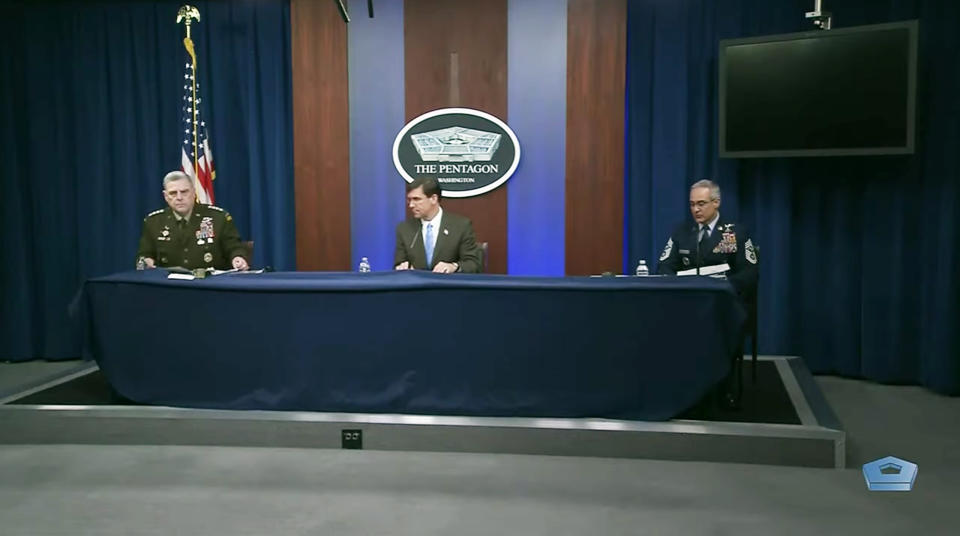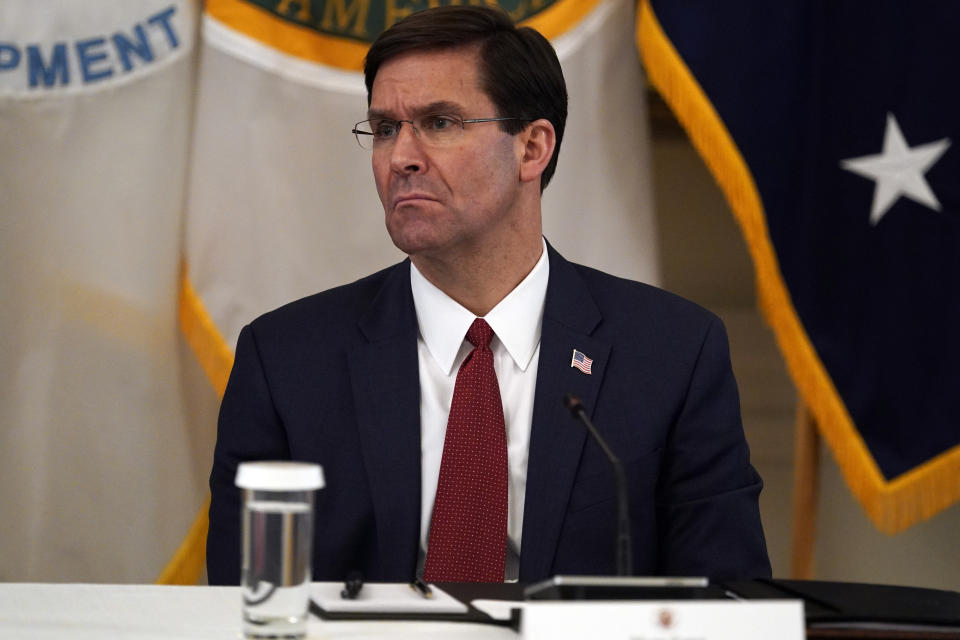Defense secretary says coronavirus vaccine will be available within months, but experts skeptical
Pentagon leaders expressed strong confidence Thursday that a coronavirus vaccine will be available by January, and perhaps as early as this fall — claims that were met with skepticism by scientific experts.
Defense Secretary Mark Esper said that he and Health and Human Services Secretary Alex Azar “will be co-chairing Operation Warp Speed,” the effort by the administration of President Trump to produce 300 million vaccine doses by January.
“I’m confident that we will be able to deliver a vaccine at scale in time” by partnering with other government agencies and the private sector, Esper said.

The secretary was speaking during a virtual town hall for the military community that also featured Chairman of the Joint Chiefs of Staff Army Gen. Mark Milley and Senior Enlisted Advisor to the Chairman Ramón Colón-López.
Speaking to what he described as a streaming audience of almost 2 million people, Milley said a vaccine is likely just several months away.
“We’re very confident that a vaccine will be online sometime beginning in the fall,” he said, adding that there are also “very high confidence levels” that Operation Warp Speed would achieve its goal “to have upward of 300 million doses by the 1st of January.”
But experts on vaccine development pushed back hard on the Defense Department leaders’ claims. “All of us in the science community are pretty baffled as to how this can happen,” said Dr. Kavita Patel, who was part of the development of a vaccine for the H1N1 virus as a senior medical official in the administration of President Barack Obama.
Even in a best-case scenario in which a vaccine under development showed promise, meeting such an aggressive manufacturing deadline would require bypassing time-consuming steps usually required to ensure a vaccine is safe and effective, according to Patel.
“What are we sacrificing for speed?” she said. “How are we going to cut corners?”
A source familiar with the Defense Department’s vaccine development efforts was only slightly less skeptical. “It’s optimistic,” the source said about the goal of producing 300 million vaccine doses by January. “A lot of stuff needs to line up in the right way for it to happen.”

But, the source added, although those working on the vaccine “are still limited by the progression of the science,” the Operation Warp Speed objective “is not outside the realm of possibility.”
By expressing such confidence, Esper and Milley were in effect putting out a message that is politically beneficial to the White House, according to Patel. “This is a signal that the administration wants to send so that there’s some optimism,” she said.
The president has sought to depict the struggle against the coronavirus as a war, a theme that Milley echoed. “We’re in a war and sort of the secret weapon here is a vaccine,” Milley said.
But, he added, the period before a vaccine is available to the military “is at least measured in months,” even if Operation Warp Speed achieves its Jan. 1 deadline, meaning service members must continue to adhere to the strict measures that have kept infection and mortality rates low across the forces. As if to underline the point, the three leaders sat at a long table with several feet between them.
All three officials paid tribute to the military for following the Pentagon’s guidelines regarding hygiene and social distancing as well as for putting up with onerous stop-movement orders that prevented many personnel from taking up new positions.
“Those measures have proven to be effective,” Milley said. “Look at our death rates and look at our infection rates in the military relative to society as a whole.”

The military has suffered only three deaths and 172 hospitalizations from COVID-19, the disease caused by the coronavirus, out of a total of about 2.1 million uniformed members. Of the 6,221 service members who have tested positive for the disease, more than half have recovered, according to figures released by the Defense Department on Thursday.
Esper acknowledged that the military’s demographic profile has also helped it escape the worst of the pandemic. “We have generally a younger, healthier, fitter force that is able to withstand the coronavirus,” he said. “If anything, they become asymptomatic carriers, which presents its own challenges.”
The military has used isolation and quarantine measures to ensure that infected service members who display no symptoms do not become a threat to their colleagues. But the Pentagon is now considering reducing how long personnel must spend in quarantine in order to be considered free of the virus, according to Milley.
After initially quarantining personnel for 21 days before cutting that to 14 days, “we’re looking very seriously at reducing it again to 10 days,” Milley said. The average incubation period for the coronavirus is between five and six days, “so if you isolate for 10, you’re going to get 98, 99 percent — perhaps — probability that if the person tests negative at the end of that, they don’t have it,” he said.
If Operation Warp Speed is successful, the massive logistical task of organizing the production and distribution of hundreds of millions of vaccine doses will fall to Gen. Gustave Perna, the head of Army Materiel Command (AMC). Trump announced May 15 that Perna would co-lead the day-to-day effort as the operation’s chief operating officer, along with former pharmaceutical executive Moncef Slaoui as chief adviser.

Perna has already moved up to Washington from AMC’s Huntsville, Ala., headquarters, according to Esper. “We’ve had two separate meetings with him now to make sure he has all the resources, authority and support he needs,” the defense secretary said.
Although timely development and production of a vaccine is the main objective of Operation Warp Speed, the initiative is “also looking at producing and supplying and distributing therapeutics and diagnostics,” Esper added.
_____
Click here for the latest coronavirus news and updates. According to experts, people over 60 and those who are immunocompromised continue to be the most at risk. If you have questions, please refer to the CDC’s and WHO’s resource guides.
Read more:



